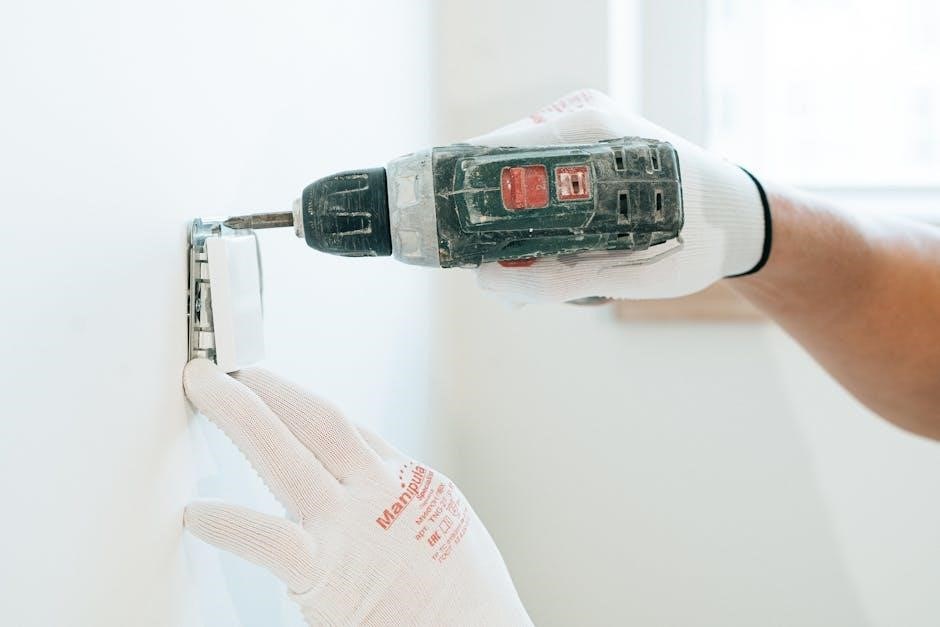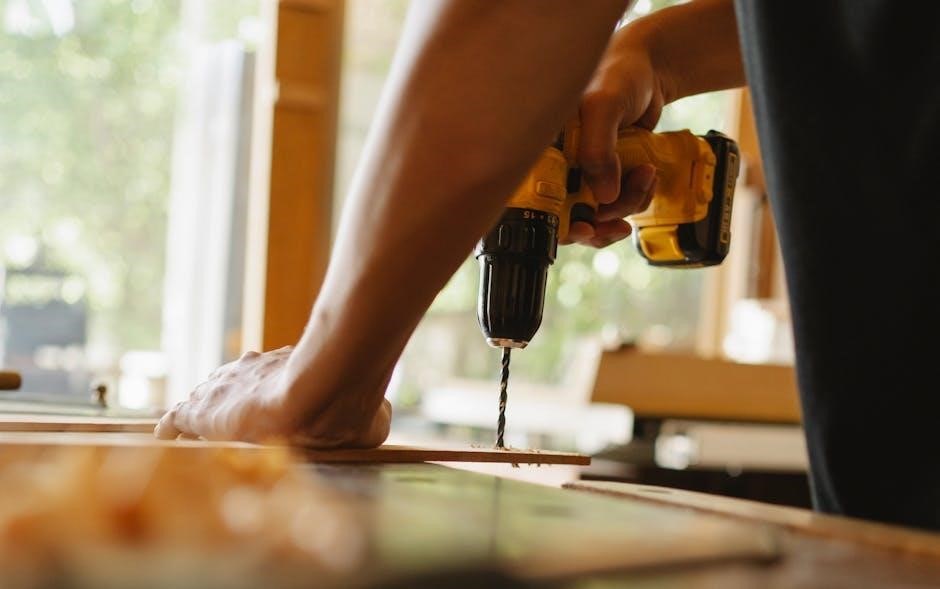th4210u2002 installation manual
Honeywell TH4210U2002 Installation Manual: A Comprehensive Guide
Welcome! This guide provides a thorough walkthrough for the Honeywell TH4210U2002 T4 Pro thermostat installation. It covers everything from preparing the tools to post-installation checks. We’ll ensure a smooth setup process for continuous, correct operation.
The Honeywell TH4210U2002, also known as the T4 Pro, is a programmable thermostat designed for ease of use and efficient home climate control. This thermostat is equipped with on-screen menus that guide you through the installation steps, making it accessible even for those with limited experience.

This model offers a universal mounting system, simplifying the physical installation process. Whether you’re replacing an older thermostat or installing a new one, the T4 Pro is designed to fit seamlessly into your existing setup. The thermostat’s user-friendly interface ensures that configuring your desired settings is straightforward.
Before beginning the installation, it’s essential to understand the basic components and functionalities of the TH4210U2002. This guide provides a comprehensive overview, ensuring you’re well-prepared for each step, from wiring connections to initial setup. By following these instructions carefully, you can ensure optimal performance and longevity of your new thermostat.
The T4 Pro is suitable for various heating and cooling systems, offering flexibility for different home environments. With its clear display and intuitive controls, the Honeywell TH4210U2002 is a reliable choice for maintaining a comfortable home environment.
Understanding the TH4210U2002 User Guide
The Honeywell TH4210U2002 T4 Pro thermostat comes with a comprehensive user guide designed to help you navigate its features and settings. This guide is an essential resource for both initial setup and ongoing use. It provides detailed instructions on how to configure the thermostat to meet your specific needs, ensuring continuous and correct operation;
The user guide covers various topics, including setting the date and time, programming your heating and cooling schedules, and understanding the different operating modes. It also includes troubleshooting tips to help you resolve common issues that may arise. Familiarizing yourself with the user guide is crucial for maximizing the benefits of your T4 Pro thermostat.
Available in multiple languages, including English, French, and Spanish, the user guide ensures accessibility for a wide range of users. It’s structured to be easy to follow, with clear explanations and helpful diagrams. By studying the user guide, you can confidently manage your home’s climate control system and optimize energy efficiency.
The user guide is readily available for download, allowing you to access it on your computer or mobile device. Whether you’re a first-time user or an experienced homeowner, the Honeywell TH4210U2002 user guide is an invaluable tool for getting the most out of your thermostat.
Key Features and Benefits of the T4 Pro Thermostat
The Honeywell T4 Pro TH4210U2002 thermostat boasts several key features designed for user-friendly operation and energy efficiency. One of its primary benefits is its ease of installation, featuring a universal mounting system (UWP) and on-screen menus that guide you through the setup process. This simplifies the installation, even for those with limited experience.
The T4 Pro offers programmable scheduling, allowing you to customize temperature settings for different times of the day, optimizing comfort and reducing energy consumption. Its clear, backlit display ensures easy readability, while intuitive controls make adjustments straightforward. The thermostat also supports both heating and cooling systems, providing year-round climate control.
Another significant advantage is its compatibility with various HVAC systems, making it a versatile choice for different homes. Furthermore, the T4 Pro includes features like adaptive intelligent recovery, which learns your heating and cooling patterns to pre-heat or pre-cool your home efficiently. This ensures your home is always at your desired temperature when you need it.
With its combination of ease of use, energy-saving features, and broad compatibility, the Honeywell T4 Pro TH4210U2002 thermostat offers a compelling solution for modern home climate control.
Preparing for Installation: Tools and Safety Precautions

Before commencing the installation of your Honeywell TH4210U2002 thermostat, careful preparation is crucial for both safety and a successful outcome. First and foremost, ensure that the power supply to your heating and cooling system is completely turned off. Locate the appropriate breaker in your electrical panel and switch it to the “off” position. This step is non-negotiable and is essential to prevent electrical shock.
Next, gather the necessary tools. You will need a Phillips head screwdriver for removing and securing screws, a small flathead screwdriver for wiring connections, and a wire stripper to prepare the wires. A level will ensure that the thermostat is mounted straight on the wall, enhancing its appearance and functionality. A flashlight or headlamp can be helpful for illuminating the wiring area, especially in dimly lit spaces.
Safety glasses should be worn to protect your eyes from debris. It is also advisable to have a voltage tester on hand to verify that the power is indeed off before touching any wires. Finally, consult the thermostat’s installation manual for specific instructions and wiring diagrams.
Taking these precautions and having the right tools ready will not only make the installation process smoother but also ensure your safety throughout the project.
Step-by-Step Installation Process: UWP Mounting System
The Honeywell TH4210U2002 thermostat utilizes the UWP (Universal Wall Plate) mounting system, designed for easy and versatile installation. Begin by separating the UWP from the thermostat body. Gently detach the thermostat from the wall plate.
Position the UWP on the wall at your desired location, ensuring it is level using a bubble level. Mark the screw holes for mounting. If you are replacing an existing thermostat, you can often use the same screw holes. For new installations, drill pilot holes at the marked locations.
Secure the UWP to the wall using the provided screws. Ensure the UWP is firmly attached and does not wobble. Next, proceed with the wiring connections as detailed in the wiring section of this manual. Once the wiring is complete, carefully align the thermostat with the UWP.
Gently press the thermostat onto the UWP until it clicks into place. Ensure it is securely attached. If an optional cover plate is desired, install it at this stage, following the instructions included with the cover plate. Finally, restore power to the thermostat at the breaker box; The thermostat should now power on.
Proceed to configure the thermostat settings as described in the configuration section.
Wiring Connections: A Detailed Guide
Proper wiring is crucial for the correct operation of your Honeywell TH4210U2002 thermostat. Before commencing, ensure power to the HVAC system is turned off at the breaker to prevent electrical shock. Identify the existing wires connected to your old thermostat, labeling each wire with the corresponding terminal designation.
Consult the wiring diagram included in this manual or printed on the thermostat itself. The TH4210U2002 supports various wiring configurations, including single-stage heating and cooling systems. Connect the labeled wires to the appropriate terminals on the UWP (Universal Wall Plate) of the new thermostat.
Ensure each wire is securely inserted into its terminal and that no bare wire is exposed. Loose connections can lead to malfunction. For heat-only or cool-only systems, refer to the specific wiring diagram for your setup. If you have a heat pump system, consult the heat pump wiring diagram.
If you are unsure about any wiring connections, consult a qualified HVAC technician. After all wires are connected, double-check each connection to ensure accuracy and tightness. Carefully tuck any excess wire back into the wall. Proceed with mounting the thermostat onto the UWP.
Once the thermostat is mounted, restore power to the system and test the functionality of heating and cooling.
Powering the Thermostat: Batteries and Electrical Connections
The Honeywell TH4210U2002 thermostat offers flexible powering options to suit different installation scenarios. It can be powered either by batteries alone or through a combination of batteries and a common wire (C-wire) connection. Understanding these options is crucial for ensuring reliable operation.
For battery-only operation, the thermostat requires two AA alkaline batteries. These batteries provide the primary power source for the device. Ensure the batteries are new and correctly installed, observing the polarity markings inside the battery compartment. Battery-only operation is suitable for systems where a C-wire is not available.
Alternatively, connecting a C-wire provides a continuous 24VAC power source to the thermostat, reducing reliance on batteries. If a C-wire is available, connect it to the designated “C” terminal on the UWP mounting plate. Using a C-wire can extend battery life and ensure consistent performance.
Even with a C-wire connection, installing batteries is recommended as a backup power source. In the event of a power outage, the batteries will maintain thermostat operation, preventing loss of settings.
Always use high-quality alkaline batteries and replace them annually to prevent corrosion and ensure optimal performance. When replacing batteries, avoid mixing old and new batteries. Dispose of used batteries responsibly according to local regulations.
Accessing and Navigating the Installer Setup (ISU)
The Installer Setup (ISU) menu on the Honeywell TH4210U2002 thermostat allows advanced configuration to match specific system requirements. Accessing and navigating this menu is essential for optimizing performance and ensuring compatibility.
To enter the ISU, press and hold the center button until the display changes. Use the up and down arrow buttons to scroll through the available parameters. The center button is used to select a parameter and enter its adjustment mode.
Within the ISU, parameters are identified by numbers. Common parameters include system type, heat stages, cool stages, and temperature swing. Refer to the thermostat’s documentation for a complete list of parameters and their corresponding numbers.
Once a parameter is selected, use the up and down arrow buttons to adjust its value. Press the center button again to save the new value. The thermostat will display “SAVE” to confirm the change.
To exit the ISU, scroll to the “DONE” option and press the center button. The thermostat will return to its normal operating mode. Always record any changes made in the ISU for future reference. Incorrect ISU settings can lead to system malfunction, so proceed with caution.
Configuring the Thermostat: Setting Date, Time, and System Parameters
After the physical installation, configuring the Honeywell TH4210U2002 is crucial for proper operation. This involves setting the date, time, and various system parameters to match your specific heating and cooling setup. Accurate configuration ensures optimal performance and energy efficiency.

To set the date and time, navigate to the main menu using the thermostat’s buttons. Look for the “Date/Time” option and select it. Use the up and down arrows to adjust the month, day, year, hour, and minute. Save each setting as you go. Proper date and time settings are important for scheduling features.
System parameters, accessible through the Installer Setup (ISU) menu, define how the thermostat controls your HVAC system. Common parameters include system type (heat pump or conventional), heating stages, cooling stages, and cycle rates. Consult your HVAC system’s documentation to determine the correct settings for these parameters.
Incorrect system parameter settings can lead to inefficient operation or even damage to your equipment. Take your time and double-check all settings before exiting the ISU menu. Save any changes made and thoroughly test system functionality.
The thermostat’s user manual provides a detailed explanation of each parameter and its available options. Using the proper settings is critical for a comfortable and energy-efficient home environment.
Troubleshooting Common Installation Issues
Even with careful preparation, you might encounter issues during the Honeywell TH4210U2002 installation. Addressing these problems quickly ensures a functional thermostat. This section covers some common issues and their solutions.
One frequent problem is the thermostat not powering on. First, verify the breaker is on. If using battery power, ensure that the batteries are new and correctly installed. If still not powering on, double-check wiring connections at both the thermostat and the HVAC system.
Another issue is the thermostat displaying an error message. Refer to the user manual for the meaning of specific error codes. The error message often indicates a wiring problem or an incompatible system setting.
If the heating or cooling system doesn’t respond after installation, check that the wiring corresponds to the correct terminals. Ensure that the system type is configured correctly in the Installer Setup menu. An incorrect system type can prevent proper communication with the HVAC equipment.
Finally, if the thermostat cycles too frequently, adjust the cycle rate setting within the Installer Setup menu. A longer cycle rate reduces the number of start-stop cycles. Proper troubleshooting ensures the TH4210U2002 operates flawlessly.
Optional Cover Plate Installation
The Honeywell TH4210U2002 thermostat offers an optional cover plate to conceal any marks or holes left by a previous thermostat. This provides a clean, professional finish to the installation. The cover plate installation is straightforward and can significantly enhance the aesthetic appeal.

Before starting, ensure the thermostat is already mounted and wired according to the previous steps. The cover plate is purely cosmetic and doesn’t affect the thermostat’s functionality. Carefully align the cover plate with the mounted UWP mounting system.
The cover plate typically snaps or screws onto the UWP mounting system. Use the provided screws if necessary, ensuring they are not overtightened to avoid damage. If the cover plate has a snap-on design, gently press until it clicks securely into place.
Verify the cover plate sits flush against the wall, concealing any imperfections. If there are gaps, recheck the alignment and attachment. Once properly installed, the cover plate provides a seamless transition between the thermostat and the wall surface.
This final touch completes the installation, leaving you with a professionally installed and aesthetically pleasing Honeywell TH4210U2002 thermostat. The optional cover plate is a simple yet effective way to enhance the overall appearance.
Post-Installation Testing and Verification
After completing the physical installation of the Honeywell TH4210U2002 thermostat, thorough testing and verification are crucial to ensure proper functionality. This step confirms that the thermostat is correctly wired, configured, and communicating effectively with your HVAC system. Begin by restoring power to the thermostat at the breaker box or switch.
Observe the thermostat display to ensure it powers on and displays the current temperature. Navigate through the thermostat’s menu to verify that the date and time are accurately set. Next, test the heating and cooling functions individually. Set the thermostat to heating mode and raise the setpoint temperature above the current room temperature.
Confirm that the heating system activates and begins to warm the space. Repeat this process for the cooling mode, lowering the setpoint temperature below the current room temperature to ensure the air conditioning system engages. Listen for any unusual noises or delays during the activation of either system.
Check the fan operation by switching the fan setting to “on” and verifying that the fan runs continuously. Also, test the auto fan setting to ensure the fan cycles on and off with the heating or cooling system. Finally, review the installer setup (ISU) settings to confirm that all parameters are correctly configured for your specific HVAC system.
Address any discrepancies or issues identified during testing before finalizing the installation. Proper post-installation testing guarantees optimal performance and prevents potential problems.
Where to Find Additional Support and Resources
Navigating the installation and setup of a thermostat can sometimes present challenges. Fortunately, a wealth of support and resources are available for the Honeywell TH4210U2002 T4 Pro thermostat. Your first point of reference should be the official Honeywell Home website, which offers a dedicated support section for thermostats.
Here, you can access downloadable manuals, including the installation guide and user manual, in multiple languages such as English, French, and Spanish. These manuals provide detailed instructions and troubleshooting tips. The website also features frequently asked questions (FAQs) and video tutorials that can visually guide you through common installation steps and configuration processes.
For more personalized assistance, you can contact Honeywell Home’s customer support team via phone or email. Their knowledgeable representatives can address specific questions and provide tailored solutions. Online forums and communities dedicated to home automation and HVAC systems can also be valuable resources.
These platforms allow you to connect with other users who have experience with the TH4210U2002 and can offer practical advice and insights. Furthermore, consider consulting with a qualified HVAC technician for professional guidance or installation assistance, especially if you encounter complex wiring or system compatibility issues.
Remember to have your thermostat model number readily available when seeking support to ensure you receive accurate and relevant information.

